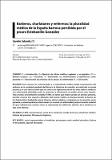Por favor, use este identificador para citar o enlazar a este item:
http://hdl.handle.net/10261/161451COMPARTIR / EXPORTAR:
 SHARE
BASE SHARE
BASE
|
|
| Visualizar otros formatos: MARC | Dublin Core | RDF | ORE | MODS | METS | DIDL | DATACITE | |

| Campo DC | Valor | Lengua/Idioma |
|---|---|---|
| dc.contributor.author | Schmitz, Carolin | - |
| dc.date.accessioned | 2018-02-28T07:49:53Z | - |
| dc.date.available | 2018-02-28T07:49:53Z | - |
| dc.date.issued | 2016 | - |
| dc.identifier | issn: 0211-9536 | - |
| dc.identifier.citation | Dynamis 36(1): 143-166 (2016) | - |
| dc.identifier.uri | http://hdl.handle.net/10261/161451 | - |
| dc.description.abstract | [EN]: In order to know about diseases and their medical treatment from the perspective of the patient in Baroque Spanish society, creative literature, especially the picaresque novel, is a valuable source that offers a representation of ideas on medicine and disease that were widespread among the population and difficult to access from other sources. The first-person narrative in the Vida y hechos de Estebanillo González (1646) offers knowledge on three different aspects of the medical world in Europe during the Thirty Years' War: Estebanillo practises various medical professions, appears in the story as a patient and comments on health practices and disease, providing highly useful material to analyze how different fields of medicine are represented in this literary work. | - |
| dc.description.abstract | [ES]: Para conocer las enfermedades y su tratamiento médico desde la perspectiva del enfermo en la sociedad española del Barroco, la literatura de creación, en particular la novela picaresca, es una valiosa fuente que nos ofrece una representación de las ideas sobre la medicina y la enfermedad difundidas entre la población y difícilmente accesibles desde otras fuentes. Vida y hechos de Estebanillo González (1646), en tanto que relato narrado en primera persona, permite conocer tres aspectos diferentes del mundo médico en Europa durante la Guerra de los Treinta Años: Estebanillo ejerce diversos oficios médicos, comparece en la narración como paciente y comenta prácticas relacionadas con la salud y la enfermedad, proporcionando material de gran utilidad para analizar cómo se representan los diferentes ámbitos de la medicina en esta obra literaria. | - |
| dc.publisher | Universidad de Granada | - |
| dc.relation.isversionof | Publisher's version | - |
| dc.rights | openAccess | - |
| dc.subject | Historia del paciente | - |
| dc.subject | History of the patient, Spanish Monarchy | - |
| dc.subject | Medical pluralism | - |
| dc.subject | Picaresque novel | - |
| dc.subject | Social representation of medicine | - |
| dc.subject | Monarquía hispánica | - |
| dc.subject | Pluralismo médico | - |
| dc.subject | Representación social de la medicina | - |
| dc.subject | Novela picaresca | - |
| dc.title | Barberos, charlatanes y enfermos: la pluralidad médica de la España barroca percibida por el pícaro Estebanillo González | - |
| dc.title.alternative | Barbers, charlatans, and the sick: The medical plurality of baroque Spain perceived by the picaresque Estebanillo González | - |
| dc.type | artículo | - |
| dc.date.updated | 2018-02-28T07:49:54Z | - |
| dc.description.version | Peer Reviewed | - |
| dc.language.rfc3066 | eng | - |
| dc.rights.license | http://creativecommons.org/licenses/by/4.0/deed.es | - |
| dc.relation.csic | Sí | - |
| dc.type.coar | http://purl.org/coar/resource_type/c_6501 | es_ES |
| item.openairetype | artículo | - |
| item.fulltext | With Fulltext | - |
| item.grantfulltext | open | - |
| item.cerifentitytype | Publications | - |
| item.openairecristype | http://purl.org/coar/resource_type/c_18cf | - |
| Aparece en las colecciones: | (INGENIO) Artículos | |
Ficheros en este ítem:
| Fichero | Descripción | Tamaño | Formato | |
|---|---|---|---|---|
| barberesteban.pdf | 176,32 kB | Adobe PDF |  Visualizar/Abrir |
CORE Recommender
Page view(s)
214
checked on 10-may-2024
Download(s)
371
checked on 10-may-2024
Google ScholarTM
Check
Este item está licenciado bajo una Licencia Creative Commons

